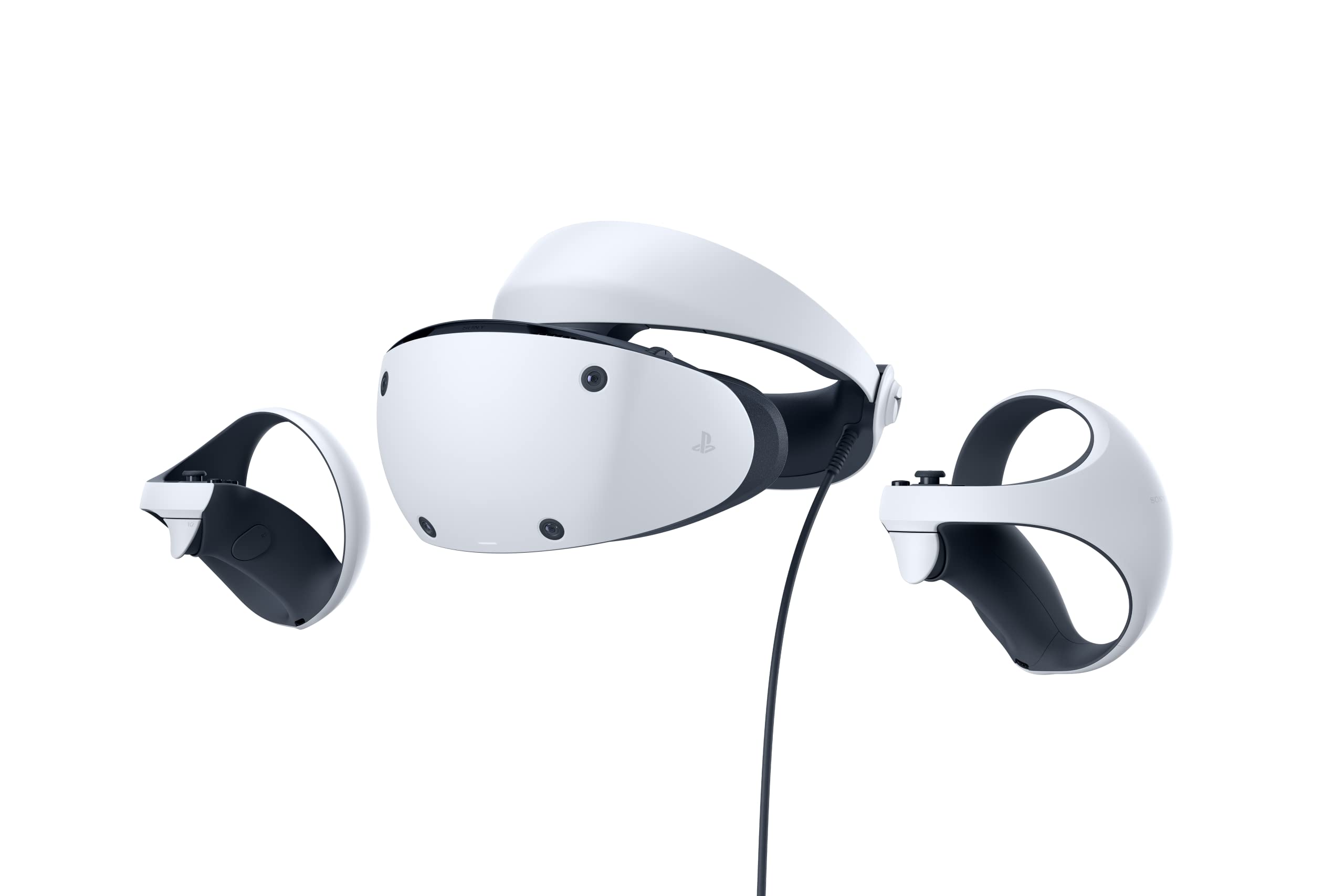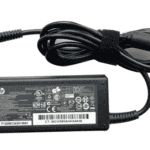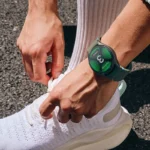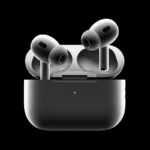Getting PlayStation VR2 to work on your PC requires specific hardware components that bridge the gap between Sony’s console-focused headset and your computer. To connect PSVR2 to a PC, you’ll need the official PS VR2 PC Adapter, a compatible DisplayPort cable, and a high-quality Bluetooth adapter for the controllers. The PC Adapter serves as the essential conversion tool, transforming the headset’s USB-C connection into the DisplayPort and USB-A inputs your computer can understand.
Sony’s adapter needs to be paired with a quality DisplayPort cable that connects directly to your PC’s DisplayPort port – not through adapters or hubs which may cause malfunctions. Many PC users overlook the Bluetooth requirements for the controllers. Standard built-in Bluetooth often falls short for maintaining a stable connection with the PS VR2 Sense controllers, which is why Sony recommends specific models: TP-Link UB500, ASUS USB-BT500, Buffalo BSBT5D205BK, or IO-DATA USB-BT50LE.
Setting up involves more than just plugging everything in. You’ll need to pair your PS VR2 Sense controllers through your PC’s Bluetooth settings after ensuring they’re fully charged. The PC adapter requires direct connection to both a power outlet and your computer’s ports – any extension cables or USB hubs can introduce connectivity problems that compromise your VR experience.
What You Need To Make PS VR2 Work On PC
To connect your PlayStation VR2 (PS VR2) to a PC, you’ll need specific hardware and software components. Here’s a comprehensive guide:
1. Hardware Requirements
- PS VR2 PC Adapter: This official adapter enables the PS VR2 to interface with a PC. It’s available through Sony’s official channels.
- DisplayPort 1.4 Cable: A high-quality DisplayPort cable is necessary to connect the adapter to your PC’s DisplayPort output. Ensure it’s not connected through adapters or hubs, as these can cause malfunctions.
- Bluetooth Adapter for Controllers: The PS VR2 Sense controllers require a stable Bluetooth connection. Standard built-in Bluetooth may not suffice, so Sony recommends specific models:
- TP-Link UB500ASUS USB-BT500Buffalo BSBT5D205BKIO-DATA USB-BT50LE
- Powerful PC: Ensure your PC meets or exceeds the following specifications:
- Operating System: Windows 10 64-bit or Windows 11 64-bitProcessor: Intel Core i5-7600 or AMD Ryzen 3 3100 (Zen 2 or later architecture)Memory: 8 GB RAM or moreGraphics Card: NVIDIA GeForce GTX 1650 or later (Turing or later architecture) or AMD Radeon RX 5500XT or laterUSB Port: USB 3.0
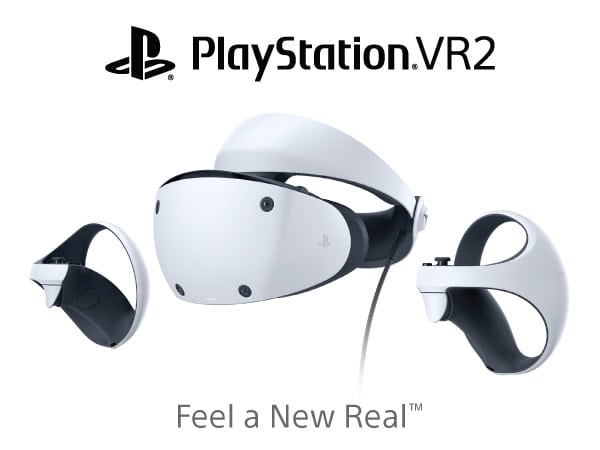
2. Software Requirements
- Steam and SteamVR: Download and install Steam from the official website, then install the SteamVR application to access VR content.
- PlayStation VR2 App: Available for free on the Steam store, this app facilitates the connection between your PS VR2 and PC, allowing you to configure settings and update firmware.
3. Setup Process
- Connect the Hardware:
- Plug the PS VR2 PC Adapter into your PC’s USB 3.0 port.
- Connect the DisplayPort 1.4 cable from the adapter to your PC’s DisplayPort output.
- Ensure the adapter is connected to a power source using the provided power adapter.
- Pair the Controllers:
- Use the recommended Bluetooth adapter to pair each PS VR2 Sense controller with your PC.
- Follow the pairing instructions provided in the PlayStation VR2 App.
- Install Necessary Software:
- Download and install Steam and SteamVR.
- Install the PlayStation VR2 App from the Steam store.
- Configure Settings:
- Launch the PlayStation VR2 App to set up your play area and update firmware if necessary.
- Use SteamVR to calibrate and customize your VR experience.
4. Considerations and Limitations
- Feature Limitations: Some PS VR2 features, such as eye tracking, HDR, adaptive triggers, and advanced haptic feedback, may not be supported when used with a PC.
- Performance Issues: Users have reported challenges, including display lag and controller desynchronization. Ensure all components are properly connected and consider using high-quality cables and adapters to minimize issues.
- Cable Management: The setup involves multiple cables, which can be cumbersome. Plan your play area accordingly to prevent tripping hazards and ensure a comfortable experience.
By ensuring you have the appropriate hardware and software, and by following the setup process carefully, you can expand your PS VR2 experience to include a wide range of PC VR games.
Key Takeaways
- The PS VR2 PC Adapter converts the headset’s connection to DisplayPort and USB-A formats your computer can use.
- Controllers must be paired via Bluetooth using one of Sony’s recommended adapters for reliable performance.
- All components need direct connections without hubs or extensions for the best experience.
Understanding PS VR2 and PC Compatibility
PlayStation VR2 can now work with PC gaming through a specific adapter setup, but users need to meet certain technical requirements for a smooth experience. The right hardware and proper Windows settings are essential for getting the headset functioning correctly.
System Requirements
To run PlayStation VR2 on PC, your computer needs to meet specific hardware benchmarks. For graphics processing, you’ll need at least an NVIDIA GeForce GTX 1650 or AMD Radeon RX 5500XT (or better). For optimal performance, an NVIDIA GeForce RTX 3060 or AMD Radeon RX 6600XT is recommended.
Your CPU should be at minimum an AMD Ryzen 3 3100 or equivalent Intel processor. 8GB RAM is the absolute minimum, but 16GB is strongly recommended for smooth operation.
Only Windows 10 64-bit or Windows 11 64-bit operating systems are supported. Earlier Windows versions won’t work with the PS VR2 setup.
A DisplayPort 1.4 connection is required on your graphics card to connect the PS VR2 PC adapter. Your PC also needs an available USB 3.0 Type-A port for the adapter’s data connection.
Hardware-Accelerated GPU Scheduling
Enabling Hardware-Accelerated GPU Scheduling in Windows is crucial for optimal PS VR2 performance on PC. This feature reduces latency and improves frame rates by allowing your GPU to manage its own memory.
To activate this setting in Windows 10/11:
- Open Settings
- Select System
- Click on Display
- Scroll down to Graphics settings
- Toggle on Hardware-accelerated GPU scheduling
This setting requires a system restart to take effect. Without this enabled, many users report connection problems and performance issues with their PS VR2 headsets.
The official PlayStation VR2 app will check if this feature is enabled during setup and configuration. If your GPU doesn’t support this feature, you may experience limited compatibility with certain games.
Essential Equipment for PC Connection
Connecting a PS VR2 to a PC requires specific hardware that transforms the PlayStation-exclusive headset into a PC-compatible virtual reality system. Users need both a specialized adapter for physical connections and proper Bluetooth hardware for controller functionality.
PC Adapter and Connection Cables
The PS VR2 PC Adapter serves as the crucial bridge between the headset and your computer. This adapter essentially splits the PS VR2’s USB-C connection into separate DisplayPort and USB-A connections that PCs can understand.
When setting up PS VR2 on PC, users must connect a DisplayPort 1.4 cable from the adapter directly to their GPU’s DisplayPort output. This cable carries the video signal to the headset and must be high quality to maintain VR performance.
The adapter must be plugged directly into a USB 3.0 Type-A port on the PC – not through any hubs or extensions. Sony specifically warns that using extension cables or USB hubs may cause malfunctions.
Users should note that the DisplayPort cable is sold separately and is not included with the PS VR2 PC Adapter.
Bluetooth Connectivity
PS VR2 Sense controllers require reliable Bluetooth connectivity to function properly with PC. Standard built-in Bluetooth adapters often prove insufficient for VR controller tracking needs.
Sony recommends four specific Bluetooth adapters that have been tested for compatibility:
- TP-Link UB500
- ASUS USB-BT500
- Buffalo BSBT5D205BK
- IO-DATA USB-BT50LE
Before pairing controllers, users should ensure both left and right controllers are fully charged. The pairing process requires enabling Bluetooth on the PC and putting controllers into pairing mode.
Some users report connectivity issues even with recommended adapters. Positioning the Bluetooth adapter in a front USB port with clear line-of-sight to controllers can improve tracking reliability.
Setting Up PlayStation VR2 with a PC
Connecting PlayStation VR2 to a PC requires specific hardware components and careful setup. The process involves both physical connections and software installation to ensure proper functionality.
Initial Setup Procedure
Start by gathering all necessary components: the PlayStation VR2 PC Adapter, a DisplayPort 1.4 cable, and a compatible Bluetooth adapter.
First, connect the PlayStation VR2 headset to the PC adapter. The adapter splits the headset’s USB-C connection into separate DisplayPort and USB-A connections.
Next, connect the DisplayPort cable from the adapter directly to your PC’s DisplayPort 1.4 port. Do not use any DisplayPort hubs or adapters as these may cause compatibility issues.
Connect the USB-A cable from the adapter to a USB 3.0 port on your PC. For optimal performance, connect directly to the PC’s USB port rather than through a USB hub.
For the controllers, ensure your PC has Bluetooth capability. If using a Bluetooth adapter, Sony recommends specific models for compatibility: TP-Link UB500, ASUS USB-BT500, Buffalo BSBT5D205BK, or IO-DATA USB-BT50LE.
To pair the controllers, disconnect any USB cables and ensure both controllers are fully charged. Turn on Bluetooth on your PC and follow the pairing process for each controller separately.
PlayStation VR2 App Installation
After completing the physical setup, you’ll need to install the PlayStation VR2 PC app, which serves as a bridge between your headset and PC VR applications.
Download the PlayStation VR2 app from the official PlayStation website. This application manages the headset’s connections and settings for PC use.
Install SteamVR from the Steam store if you plan to play SteamVR games. The PS VR2 is compatible with most SteamVR games when properly configured.
Open the PlayStation VR2 app and follow the on-screen instructions to complete the configuration process. This includes setting up tracking, adjusting display settings, and confirming controller connectivity.
Run a test to ensure everything works properly. The PlayStation VR2 app includes diagnostic tools to verify all components are functioning correctly before launching any VR applications.
Optimizing Your VR Gaming Experience
Once you have the necessary hardware to connect your PS VR2 to your PC, fine-tuning your setup will dramatically improve gameplay quality and comfort. Both physical space configuration and controller settings play crucial roles in creating an immersive experience.
Adjusting Play Area Settings
SteamVR offers robust room setup options that help maximize your PS VR2 performance on PC. To begin, clear as much physical space as possible – most VR games recommend at least 6.5 × 5 feet of unobstructed area.
To configure your play area:
- Open SteamVR
- Select Room Setup from the menu
- Choose between Standing Only or Room-Scale based on your available space
- Follow the on-screen instructions to map your boundaries
For PlayStation VR2 headsets, enable Standing Mode if space is limited. This setting works well for seated games and experiences that don’t require much movement.
Room lighting also affects tracking quality. Moderate, consistent lighting works best – avoid direct sunlight or completely dark rooms. Most SteamVR games are fully compatible with the PS VR2 adapter, making proper play area configuration essential.
Enhancing Controller Responsiveness
The PS VR2 Sense Controllers offer unique features that require proper configuration to work optimally on PC. Their haptic feedback, adaptive triggers, and finger touch detection can enhance immersion when correctly set up.
To maximize controller performance:
- Ensure your Bluetooth adapter is one of Sony’s recommended models (TP-Link UB500, ASUS USB-BT500, Buffalo BSBT5D205BK, or IO-DATA USB-BT50LE)
- Place the Bluetooth adapter in a front USB port with clear line-of-sight to controllers
- Configure controller bindings for each game through SteamVR settings
Battery life can affect responsiveness. Keep controllers charged between sessions, and consider having backup USB-C cables nearby for longer gaming sessions.
For games that support haptic feedback, adjust intensity levels in SteamVR settings. Some users prefer reduced settings (30-50%) to prevent hand fatigue during extended play.
Advanced Features of PlayStation VR2 on PC
The PlayStation VR2 brings several cutting-edge features to PC users that elevate the virtual reality experience beyond basic headset functionality. These technologies work together to create more immersive and responsive VR environments when properly configured with your PC setup.
Understanding Foveated Rendering
Foveated rendering is one of the PSVR2’s most impressive technological features now available to PC users. This technique renders images at full resolution only where your eyes are focused, while reducing detail in peripheral vision areas.
How it works on PC:
- Uses eye tracking to determine your focal point
- Reduces GPU workload by up to 60% compared to standard rendering
- Requires proper configuration in SteamVR settings to activate
For optimal foveated rendering performance, you’ll need a GPU that supports Variable Rate Shading (VRS). Most RTX 3000 series or newer NVIDIA cards and AMD RX 6000 series or newer will support this feature. The performance boost is substantial, allowing games to run at higher frame rates with better visual quality.
PC users can adjust foveated rendering intensity through third-party applications like OpenVR-FSR to fine-tune the balance between performance and visual clarity.
Utilizing Eye Tracking
The PSVR2’s sophisticated eye tracking system creates new interaction possibilities when connected to your PC. This technology follows your gaze direction and can translate it into in-game actions.
PC applications of eye tracking:
- Menu navigation without controllers
- Natural targeting in shooting games
- Character interaction through eye contact
- Automatic IPD (interpupillary distance) adjustment
Eye tracking requires the PlayStation VR2 PC Adapter to pass data correctly to your computer. Some games will need manual configuration to recognize the eye tracking input. Popular titles like Half-Life: Alyx and Microsoft Flight Simulator have implemented support for this feature.
The technology works by using infrared cameras that monitor your pupils roughly 120 times per second, creating an incredibly responsive experience once properly set up.
Experiencing 3D Audio
The PSVR2’s 3D audio capabilities transfer seamlessly to PC, creating convincing spatial soundscapes that enhance immersion. This technology simulates how sound waves interact with your head and ears.
Setting up 3D audio:
- Connect headphones directly to the PSVR2 headset
- Enable 3D audio in your PC’s sound settings
- Select “PlayStation VR2 Audio” as your default playback device
The system uses Head-Related Transfer Function (HRTF) technology to position sounds accurately in virtual space. This creates the impression that noises are coming from specific locations around you, including above and below.
PC gamers benefit from the headset’s built-in haptic feedback that works in tandem with 3D audio. When properly configured, footsteps can both be heard approaching from behind and felt through subtle vibrations, creating a multi-sensory experience that dramatically improves immersion in games and applications.
Troubleshooting Common Issues
When using PS VR2 with a PC, users may encounter technical difficulties that can interrupt the VR experience. Most problems fall into two categories: DisplayPort connection failures and Bluetooth controller connectivity issues.
Addressing DisplayPort Connection Problems
If you receive the error message “Check DisplayPort Connection,” first verify that all cables are securely connected. Make sure the DisplayPort cable meets the 1.4 or higher specification required for PS VR2.
Try these fixes:
- Connect the PS VR2 PC adapter to a different DisplayPort on your graphics card
- Restart the PlayStation VR2 application
- Update your graphics card drivers to the latest version
Sometimes the issue stems from the USB connection. Connect the PS VR2 PC adapter directly to a USB 3.0 port on your computer, not through a hub. If problems persist, try these additional steps:
- Reconnect the PC adapter to the same USB 3.0 port
- Try a different USB 3.0 port on your PC
- Check if your PC went into sleep mode, which can cause connection issues with SteamVR
Solving Bluetooth Connectivity Errors
Controller tracking issues often stem from Bluetooth connectivity problems. Sony recommends specific Bluetooth adapters (TP-Link UB500, ASUS USB-BT500, Buffalo BSBT5D205BK, or IO-DATA USB-BT50LE) to avoid compatibility issues.
For better controller tracking:
- Install the latest Bluetooth driver from the manufacturer’s website
- Connect your Bluetooth adapter to a USB 2.0 port (not 3.0)
- Position the Bluetooth adapter away from USB 3.0 ports and other wireless devices to minimize interference
If controllers disconnect frequently or have erratic behavior, try these solutions:
- Remove and re-pair the controllers in SteamVR
- Replace batteries if they’re low on power
- Check for physical obstructions between the controllers and Bluetooth adapter
USB 3.0 ports can create radio frequency interference with Bluetooth signals. Place your Bluetooth dongle as far as possible from USB 3.0 ports to improve connection stability.
Alternate VR Solutions for PC
While PlayStation VR2 offers an exciting option for PC VR gaming, several other virtual reality headsets provide different features and connectivity options without requiring special adapters or complex setups.
Exploring Other VR Headsets
The Meta Quest series offers a popular alternative to PS VR2 for PC gaming. Quest 3 and Quest 2 connect to PCs using either a USB-C cable (Meta Link) or wirelessly via Air Link. These headsets don’t require a PlayStation 5 and work as standalone devices too.
Popular PC VR Headsets:
- Valve Index: Premium option with excellent tracking and controllers
- HTC Vive Pro 2: High-resolution display with wireless adapter option
- HP Reverb G2: Best visual clarity in its price range
- Pimax Crystal: Ultra-wide field of view for immersive experiences
Most PC-native headsets connect directly via DisplayPort and USB, eliminating the need for additional adapters. Setup is typically more straightforward than the PS VR2 PC adapter process described by PlayStation support.
SteamVR Compatibility with Other Devices
SteamVR serves as the primary platform for PC VR gaming, supporting almost all major VR headsets. This universal compatibility gives PC users more hardware options than the PlayStation ecosystem.
Games like Half-Life: Alyx, Beat Saber, and No Man’s Sky VR run on SteamVR with various headsets. The platform provides a unified interface for VR Game libraries regardless of which VR Headset you choose.
SteamVR Benefits:
- Extensive game library with frequent sales
- Compatible with most VR controllers
- Built-in performance adjustment tools
- Community workshop mods and enhancements
Unlike PS VR2, which requires special Bluetooth adapters for controller connectivity, most PC VR systems use integrated tracking solutions. This eliminates compatibility concerns with specific Bluetooth adapter models mentioned in PlayStation’s setup guide.
Understanding VR Game Compatibility
When using PlayStation VR2 on PC, game compatibility is a key consideration for users. Not all VR games will work with the PS VR2 headset on PC, and some may require additional setup or configuration.
Compatible VR Games for PlayStation VR2 on PC
The PlayStation VR2 can run many PC VR titles through SteamVR, which serves as the primary platform for VR gaming on PC. Popular titles like Half-Life: Alyx are compatible with the PS VR2 when using the proper adapter and setup.
To use SteamVR games with PS VR2, users will need to:
- Install Steam and SteamVR on their PC
- Make sure their PC meets the minimum requirements for VR gaming
- Connect the PS VR2 using the proper adapter and cables
Important compatibility notes:
- Some games may have control mapping issues that require customization
- Not all SteamVR games are fully compatible with PS VR2
- Performance may vary based on PC specifications
Users should check that their PC has sufficient power for VR gaming. Most VR games require at least a 10th gen i7 + RTX 2080 or newer for optimal performance.
The PS VR2’s see-through view feature still works on PC, allowing users to view their surroundings without removing the headset. This is activated by pressing the function button on the headset.

